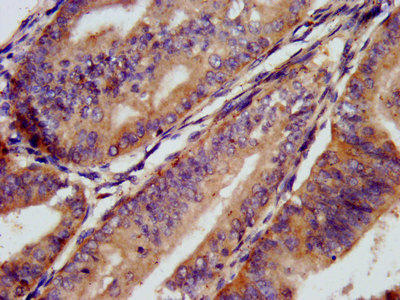Description
| Antibody Name: | CD1E Antibody (PACO56744) |
| Antibody SKU: | PACO56744 |
| Size: | 50ug |
| Host Species: | Rabbit |
| Tested Applications: | ELISA, IHC |
| Recommended Dilutions: | ELISA:1:2000-1:10000, IHC:1:200-1:500 |
| Species Reactivity: | Human |
| Immunogen: | Recombinant Human T-cell surface glycoprotein CD1e, membrane-associated protein (198-294AA) |
| Form: | Liquid |
| Storage Buffer: | Preservative: 0.03% Proclin 300 Constituents: 50% Glycerol, 0.01M PBS, pH 7.4 |
| Purification Method: | >95%, Protein G purified |
| Clonality: | Polyclonal |
| Isotype: | IgG |
| Conjugate: | Non-conjugated |
 | IHC image of PACO56744 diluted at 1:300 and staining in paraffin-embedded human endometrial cancer performed on a Leica BondTM system. After dewaxing and hydration, antigen retrieval was mediated by high pressure in a citrate buffer (pH 6.0). Section was blocked with 10% normal goat serum 30min at RT. Then primary antibody (1% BSA) was incubated at 4°C overnight. The primary is detected by a biotinylated secondary antibody and visualized using an HRP conjugated SP system. |
| Background: | T-cell surface glycoprotein CD1e, soluble binds diacetylated lipids, including phosphatidyl inositides and diacylated sulfoglycolipids, and is required for the presentation of glycolipid antigens on the cell surface. The membrane-associated form is not active. |
| Synonyms: | T-cell surface glycoprotein CD1e, membrane-associated (hCD1e) (R2G1) (CD antigen CD1e) [Cleaved into: T-cell surface glycoprotein CD1e, soluble (sCD1e)], CD1E |
| UniProt Protein Function: | T-cell surface glycoprotein CD1e, soluble binds diacetylated lipids, including phosphatidyl inositides and diacylated sulfoglycolipids, and is required for the presentation of glycolipid antigens on the cell surface. The membrane-associated form is not active. |
| UniProt Protein Details: | |
| NCBI Summary: | This gene encodes a member of the CD1 family of transmembrane glycoproteins, which are structurally related to the major histocompatibility complex (MHC) proteins and form heterodimers with beta-2-microglobulin. The CD1 proteins mediate the presentation of primarily lipid and glycolipid antigens of self or microbial origin to T cells. The human genome contains five CD1 family genes organized in a cluster on chromosome 1. The CD1 family members are thought to differ in their cellular localization and specificity for particular lipid ligands. The protein encoded by this gene localizes within Golgi compartments, endosomes, and lysosomes, and is cleaved into a stable soluble form. The soluble form is required for the intracellular processing of some glycolipids into a form that can be presented by other CD1 family members. Many alternatively spliced transcript variants encoding different isoforms have been described. Additional transcript variants have been found; however, their biological validity has not been determined. [provided by RefSeq, Jun 2010] |
| UniProt Code: | P15812 |
| NCBI GenInfo Identifier: | 14030479 |
| NCBI Gene ID: | 913 |
| NCBI Accession: | AAK52914.1 |
| UniProt Secondary Accession: | P15812,Q5TDJ9, Q5TDK3, Q5TDK4, Q5TDK5, Q5TDK6, Q5TDK8 Q5TDL1, Q712E4, Q712E5 |
| UniProt Related Accession: | P15812 |
| Molecular Weight: | 32,303 Da |
| NCBI Full Name: | CD1E, partial |
| NCBI Synonym Full Names: | CD1e molecule |
| NCBI Official Symbol: | CD1E |
| NCBI Official Synonym Symbols: | R2; CD1A |
| NCBI Protein Information: | T-cell surface glycoprotein CD1e, membrane-associated |
| UniProt Protein Name: | T-cell surface glycoprotein CD1e, membrane-associated |
| UniProt Synonym Protein Names: | R2G1; CD_antigen: CD1e |
| Protein Family: | T-cell surface glycoprotein |
| UniProt Gene Name: | CD1E |
| UniProt Entry Name: |






